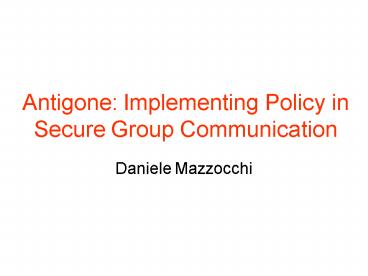Antigone: Implementing Policy in Secure Group Communication PowerPoint PPT Presentation
1 / 26
Title: Antigone: Implementing Policy in Secure Group Communication
1
Antigone Implementing Policy in Secure Group
Communication
- Daniele Mazzocchi
2
What is Antigone
- Antigone is a framework for the definition and
implementation of security policies in group
comm. systems - Flexible Security Policy
- Flexible Threat Model
- Security Infrastructure Independence
- Transport Layer Independence
- Performance
3
Taxonomy of group security policies
- session rekeying policy
- defines set of events that leads to rekey
- data security policy
- security services offered to application messages
- membership awareness policy
- availability and accuracy of membership infos
- process failure policy
- type of failure detected and way to recover
- access control policy
- the rights of the group members
4
Session rekeying policy
- what it is necessary to achieve
- session key independence
- membership forward secrecy
- membership backward secrecy
- limited lifetime
- close relation between session rekeying and group
membership - a policy is sensitive to an event if the session
key changes after the event occured
5
rekeying policies
- time-sensitive policy
- protection against DoS (aimed to force to use the
same key) during a rekeying - leave-sensitive policy
- join-sensitive policy
- membership-sensitive
6
Data security policy
- the following services integrity (1),
confidentiality (2), group authenticity and
sender authenticity - group authenticity a message was effectively
transmitted by a group member - proof of knowledge of the session key trough (1)
and (2) - sender authenticity strong authentication
(e.g., non repudiation)
7
Membership policy
- best-effort membership
- no guarantees about timeliness or accuracy
- positive membership
- all the members in the view are participating in
the group - negative membership
- every members who has access to the key is listed
in the view - perfect membership
- both positive and negative membership guaranteed
8
Other policies
- process failure policy
- which are the failures detected, security of
failure detection process - access control policy
- classical rights management
- strictly related to the authentication process
9
Antigone Architecture
10
Supported policies
- members assumed as trusted
- active attackers
- rekeying is session key indipendent
- only one simple access control right the ability
to gain access to the group. Group access stored
in an ACL at the group leader - arbitrated group, no peer groups support
11
Principals in Antigone
session leader
TTP
member1
LAN/WAN
member2
membern
12
Terminology
- G group identifier (8 bytes string)
- g view identifier (concatenation of G with a
random value) - ...K denotes encryption under key K
- SA is the sequence number of A (reset following a
rekey) - Pug and Prg is an asymmetric key pair
13
Authenticate
- A?SL A,G,I0
- SL?TTPSL,A,I1
- TTP?SL?SL,AAKsl?SLKa,I1Ksl
- SL?ASL,A,g,A,I0,I2,policy block,Pug ?sl,a
- (reject)SL?ASL,A,G,I0,H(SL,A,G,I0) ?sl,a
- ?sl,a SLKa this value needs not to be
transmitted, A can computes it by herself - based on Leighton-Micali protocol
14
Join
- A?SL A,A,I2 ?sl,a
Leave
- A?SL A,g,A,SA,g,B SKg ?sl,a
15
Rekey/Group Membership
- SL?Ag,SSL,(A,g,SKg ?sl,a), H(g,SSL,(A,g,SKg
?sl,a)SKg - SL?Ag,SSL,(A,g,SKg ?sl,a),B,C,D,...
H(g,SSL,(A,g,SKg ?sl,a),B,C,D,...SKg - SL?groupg1,SSL,(A,g1,SKg1 ?sl,a),
(B,g1,SKg1 ?sl,b),H(g,SSL,...SKg1
16
Failure Detection
- A?SLSAi,?k-i,g,A, SA0, ?k,
H(g, A, SA0, ?k) ?sl,a member heartbeat - SL?group SSLi, ?k-i,g,SL, SSL0, ?k, H(g, A,
SSL0, ?k)Prg SL heartbeat - A?SL g,A
- based on hash chain ?0x, ?1f(x), ?2f2(x),...,
?kfk(x) - SAi SA0 i
17
Characteristics
- a policy block is distributed to each member at
authentication time - no negotiation
- no enforcement of policy dependencies (e.g.,
without failure detection is possible to have
problem with policies that are membership
sensitive) - views are presented and guaranteed only at
session key distribution and rekeying
18
Principles of policy in secure group
19
Some generalities
- Group Owner(GO) the policy issuer, considered
trusted by the members - Group Controller (GC) in charge of key
dissemination, enforces group access control - Subordinate Group Controller (SGC), no session
key creation - Member (M)
20
Security relevant group actions
- policy creation -create/assert policy
- policy modification
- grant rights - granted to external entities
- key creation
- group destruction
- key dissemination
- rekey action initiation - used for eject member
- authorize member
- admit member
- audit group
- key access
21
What is necessary to define
- Identification must be unambiguous
- Authorization the policy must identify the
entities allowed to perform protected action - Access Control mapping between authorized
parties and actions in group - Mechanism how security requirements for the
group are to be addressed - Verification every policy must present evidence
of its validity. Origin, integrity and freshness
are asserted
22
1. Enforcement of group policy must be consistent
across a group
- the view of the policy must be the same during
the life of the group - two concepts
- mechanism equivalence
- synchronization (e.g., must reach consensus about
the use of a new key after rekeying)
23
2.Only authorized entities can affect the
security posture of the group
- for example a new member must not be permitted to
admit further members unless explicitely
authorized by the policy - the actions must be associated only with members
allowed to perform them - policy creation, key dissemination, initiate
rekey, group destruction
24
3. Group content must be protected
- carefully enforce access control (e.g., the
session key must be accessible only to authorized
members) - example access only with a valid certificate
25
4. Group must be capable of recovery from
security relevant failures to a secure state
- policy must specify how compromises are detected
and the mechanism for the recovery - e.g., use sophisticated rekeying approaches (the
compromised member are excluded after rekey) - try to recover also from external problem (e.g.,
network partition)
26
GSAKMP
- Group Secure Association Key Management Protocol
- Analysis of the full compliance of GSAKMP to the
principles expressed before

